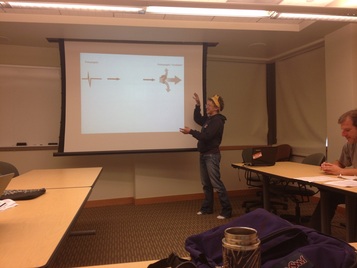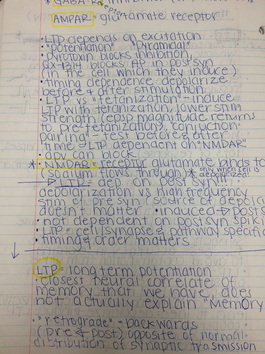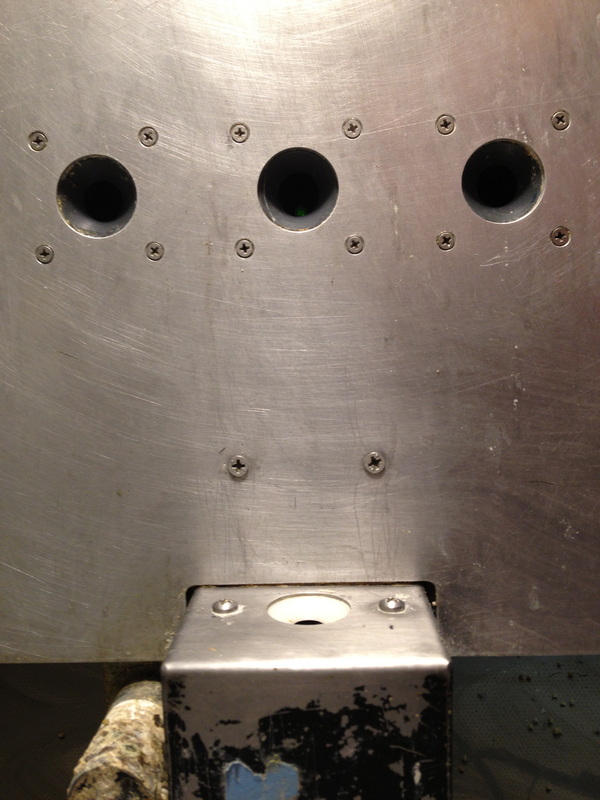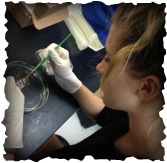
Okay, we all know this feeling - Sitting in a class you're totally familiar with, looking at the person presenting, hearing the discussion of our peers, and still thinking, "What is even going on." (Personally, once I've reached that point, I'm no longer asking it as a question - It's a statement of just how dumbfounded I am in that moment. I just keep taking notes and figure that at some point I'll be able to review, ask questions, and eventually understand.)
Now imagine taking away the familiarity of the content, and just add the fact that you are madly curious about what's going on around you. While that is generally me most of the time, this class really exemplified that feeling.
Now imagine taking away the familiarity of the content, and just add the fact that you are madly curious about what's going on around you. While that is generally me most of the time, this class really exemplified that feeling.

Today Krista and I walked from the lab to her Neuroscience class - but it's not what you're thinking of as a general "class" - there were six students, one intern, and a professor who knows how to present a great scientific debate.
The class was structured around four papers - two read and presented by Alison (a student in the class), and two read and presented by Krista. These papers focused on a great debate of Neuroscience - Does LTP occur in the pre or post synaptic cleft? I think I know what you're thinking... What in the world is an LTP, why does it occur and are the post synaptic clefts the where of this question? If this is what you're thinking, you're on the road to being where I was at the beginning of the class, and in reality... all signed pointed to confused.
Just to give you a quick heads-up on where we're going, here's a few pointers on the vocabulary of the seminar:
LTP: Long-term Potentiation... Krista defined it for me as "the closest neural correlate of memory that we have, but it doesn't actually explain 'memory.'"
GABA-R: Inhibition channel for Chlorine (Cl-). 'R' just stands for "receptor." So we'd call this the "Gaba Receptor"
NMDA-R: Glutamate-binding receptor that Sodium flows through when the cell is depolarized.
AMPA-R: Another glutamate receptor (which is not one that Sodium flows through).
If you're still confused about what a synaptic cleft is, imagine your neuronal anatomy. Starting from left to right we have dendrites, which are attached to the soma (or the body) of the neuron. Currents travel down the axon where they reach the presynaptic cleft - where signals will be sent from in a synapse. The dendrite of the next neuron which will receive the message (sent from the presynaptic cleft) is called the post synaptic cleft.
In the simplest terms (and from my best understanding) a range of neuroscientists in the 1900's posed the question of wondering whether LTP occurs in the pre or post synaptic cleft... And, as all researching scientists would, they designed experiments to test their hypotheses. Although it seems like a "left or right" question, what I learned from student response yesterday as well as my own experimental and research based experiences - science is never simple, and science is never 'just' left or right.
So a number labs interested in finding an answer to this question conducted a various range of experiments based around their knowledge of neuronal receptors (those GABA, NMDA, and AMPA receptors we talked about earlier)... and although one scientist seemed to present research that leaned towards LTP occurring in the presynaptic cleft, the rest of the research was overwhelmingly leaning towards the post synaptic cleft... That's where things got interesting in our class...
At the end of both Alison and Krista's presentations, the professor asked the seven of us whether we thought LTP was presynaptic or post synaptic. "Presynaptic," he said. No one raised their hand. "Post synaptic," he said. (I reluctantly raised my hand about 2 inches from the desk so that if I was wrong, I could make an excuse that it was just a twitch or something.) "Really? No one!? Then what?" he asked. "It's both!" everyone (but me) responded. I was puzzled. The research in my eyes had clearly shown it was post. Was I misunderstanding? Misinterpreting? Was there prior knowledge of the subject that I didn't have? What was I missing?
It turns out that the professor agreed - there was so much research supporting the post synaptic cleft, he didn't understand the thought of it being both either. Everyone seemed to note that there was evidence for both pre and post synaptic, and therefore it meant that LTP occurred in both. The professor had made an interesting observation over the time that he'd been teaching the class... That the first years he taught the lesson, the class leaned towards presynaptic. The next few years it was about half and half. A few years after that it was post. And this year it was both.
He ended the class by asking us to wonder about the objectives and interpretive results of scientific experiments. What made us perceive the evidence the way we did? And how was or is that perception influenced by the era in which we study our sciences?
Here's the lesson of the day - I didn't truly realize how comfortable I am in my routine educational environment until I was thrown into a completely new, unfamiliar and complex thread of knowledge... I've never been so attentive when I was confused... And I never thought I would say I loved being confused! I guess that's just another way that this internship has blown my mind.
Tomorrow our schedule is to go watch Emily's thesis defense in the morning (she's graduating from the program and earning her doctorate!), spend some time working on both of our presentations (for Krista it's Socrates, for me it's next week's introduction and project presentation), meet up with Ashley (researcher from the Salk Institute) and Sabyn (interning at the Salk) for lunch, and finally head off to the Socrates show case! It's going to be a little jam-packed and I'm going to love it.
The class was structured around four papers - two read and presented by Alison (a student in the class), and two read and presented by Krista. These papers focused on a great debate of Neuroscience - Does LTP occur in the pre or post synaptic cleft? I think I know what you're thinking... What in the world is an LTP, why does it occur and are the post synaptic clefts the where of this question? If this is what you're thinking, you're on the road to being where I was at the beginning of the class, and in reality... all signed pointed to confused.
Just to give you a quick heads-up on where we're going, here's a few pointers on the vocabulary of the seminar:
LTP: Long-term Potentiation... Krista defined it for me as "the closest neural correlate of memory that we have, but it doesn't actually explain 'memory.'"
GABA-R: Inhibition channel for Chlorine (Cl-). 'R' just stands for "receptor." So we'd call this the "Gaba Receptor"
NMDA-R: Glutamate-binding receptor that Sodium flows through when the cell is depolarized.
AMPA-R: Another glutamate receptor (which is not one that Sodium flows through).
If you're still confused about what a synaptic cleft is, imagine your neuronal anatomy. Starting from left to right we have dendrites, which are attached to the soma (or the body) of the neuron. Currents travel down the axon where they reach the presynaptic cleft - where signals will be sent from in a synapse. The dendrite of the next neuron which will receive the message (sent from the presynaptic cleft) is called the post synaptic cleft.
In the simplest terms (and from my best understanding) a range of neuroscientists in the 1900's posed the question of wondering whether LTP occurs in the pre or post synaptic cleft... And, as all researching scientists would, they designed experiments to test their hypotheses. Although it seems like a "left or right" question, what I learned from student response yesterday as well as my own experimental and research based experiences - science is never simple, and science is never 'just' left or right.
So a number labs interested in finding an answer to this question conducted a various range of experiments based around their knowledge of neuronal receptors (those GABA, NMDA, and AMPA receptors we talked about earlier)... and although one scientist seemed to present research that leaned towards LTP occurring in the presynaptic cleft, the rest of the research was overwhelmingly leaning towards the post synaptic cleft... That's where things got interesting in our class...
At the end of both Alison and Krista's presentations, the professor asked the seven of us whether we thought LTP was presynaptic or post synaptic. "Presynaptic," he said. No one raised their hand. "Post synaptic," he said. (I reluctantly raised my hand about 2 inches from the desk so that if I was wrong, I could make an excuse that it was just a twitch or something.) "Really? No one!? Then what?" he asked. "It's both!" everyone (but me) responded. I was puzzled. The research in my eyes had clearly shown it was post. Was I misunderstanding? Misinterpreting? Was there prior knowledge of the subject that I didn't have? What was I missing?
It turns out that the professor agreed - there was so much research supporting the post synaptic cleft, he didn't understand the thought of it being both either. Everyone seemed to note that there was evidence for both pre and post synaptic, and therefore it meant that LTP occurred in both. The professor had made an interesting observation over the time that he'd been teaching the class... That the first years he taught the lesson, the class leaned towards presynaptic. The next few years it was about half and half. A few years after that it was post. And this year it was both.
He ended the class by asking us to wonder about the objectives and interpretive results of scientific experiments. What made us perceive the evidence the way we did? And how was or is that perception influenced by the era in which we study our sciences?
Here's the lesson of the day - I didn't truly realize how comfortable I am in my routine educational environment until I was thrown into a completely new, unfamiliar and complex thread of knowledge... I've never been so attentive when I was confused... And I never thought I would say I loved being confused! I guess that's just another way that this internship has blown my mind.
Tomorrow our schedule is to go watch Emily's thesis defense in the morning (she's graduating from the program and earning her doctorate!), spend some time working on both of our presentations (for Krista it's Socrates, for me it's next week's introduction and project presentation), meet up with Ashley (researcher from the Salk Institute) and Sabyn (interning at the Salk) for lunch, and finally head off to the Socrates show case! It's going to be a little jam-packed and I'm going to love it.


 RSS Feed
RSS Feed